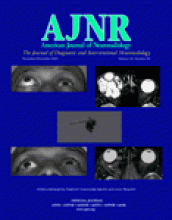Abstract
BACKGROUND AND PURPOSE: Venous drainage patterns are a major determinant of clinical outcome in intracranial dural arteriovenous fistula (DAVF) patients. In this study, we sought to identify MR imaging finding differences between DAVF types classified on the basis of venous drainage patterns.
METHODS: Twenty-seven patients diagnosed as having DAVFs by conventional angiography were included. Medical records (n = 27), and MR imaging (n = 27) and MR angiography (MRA; n = 11) findings were retrospectively reviewed. MR imaging findings included flow void cluster, engorged ophthalmic vein/proptosis, white matter hyperintensity, intracranial hemorrhage, dilated leptomeningeal or medullary vessels, venous pouch, and leptomeningeal or medullary vascular enhancements. MRA findings included identifiable fistula, venous flow-related enhancement, and prominent extracranial vessels. Patients’ presentations and MR imaging findings were compared among angiographic type I, II, and III cases (according to Borden’s classification), and MRA findings were compared between cases with and without retrograde leptomeningeal venous drainage (RLVD).
RESULTS: Patient presentations were aggressive in one (13%) of the type I cases, 5 (50%) of the type II cases, and 8 (100%) of the type III cases (P = .002). Aggressive presentations included hemorrhage, focal neurologic deficits, seizures, intracranial hypertension, and an altered mental status. MR images showed significantly higher frequencies of dilated leptomeningeal or medullary vessels in a higher type [0 in type I, 5 (42%) in type II, and 7 (100%) in type III], and of leptomeningeal or medullary vascular enhancements [0 in type I, 4 (33%) in type II, and 7 (100%) in type III]. By using MRA, fistulas were identified only in cases with RLVD (5 [83%]). Venous flow-related enhancement was present in 10 cases (91%). A sole false-negative case on MRA, as compared with conventional angiography, resulted from nonvisualization of the slow venous flow (8%). No false-positive fistula was found at the other intracranial sites in all cases. Overall, MRA assessment for DAVF was adequate for both fistula and venous flow-related enhancement in 10 cases (91%) and inadequate in a remaining case because of the fistular location out of field.
CONCLUSION: MR imaging demonstration of leptomeningeal or medullary vascular dilation and enhancements may be associated with features that are considered predictors of a poor outcome and indicates a need for urgent therapy in intracranial dural AVF patients. MRA is a complementary tool for the identification of dural AVF with venous flow-related enhancement.
- Copyright © American Society of Neuroradiology












